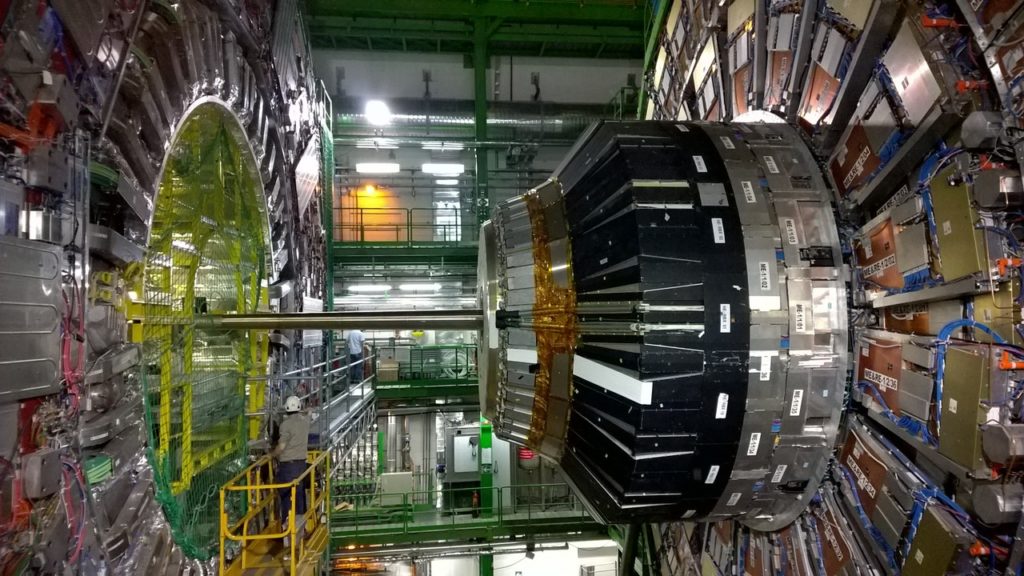
I learned this today. The Higgs boson is an elementary particle associated with the Higgs field. The Higgs field is an energy field that transmits mass to the things that move through it.
A boson is a particle that carries a force and energy. Bosons are at the route of the fundamental forces, although there are also bosons that are not fundamental forces. A photon is a boson and it carries the electromagnetic force. Mesons are bosons and they carry the nuclear force. Gluons are a boson and they carry the strong force. W and Z bosons carry the weak force. Gravitons are a boson and they carry the gravitational force. (At least, they would be, but they are only theoretical.)
The boson was named for the Indian scientist Satyendra Nath Bose, who worked with Einstein to come up with the Bose-Einstein condensate. (That is something to be learned on another day.)
And the Higgs is a boson. It is the particle that interacts with other particles to give them mass. It is the physical manifestation of the Higgs field. The difference with the Higgs boson is that it does not spin. All bosons have spin. And all of the different particles spin at the same speed. All electrons spin at the same spend and all photons spin at the same speed, which is twice as fast as an electron. And this rate of spin never changes over time. It doesn’t speed up or slow down. But the Higgs boson does not spin.
The Higgs mechanism was proposed by Peter Higgs and five other scientists in 1964. The problem they faced was mass. The photon has zero mass. This is why it can travel at the speed of light. Gluons are also massless. The problem that Higgs and the others faced is that no other particles are massless. Why?
Particles must have mass for there to be things in this universe. In fact, if all particles were massless, there would be nothing in this universe and Peter Higgs would never have existed to ask his question. If electrons and protons had no mass, an electron could never be captured by a proton and create hydrogen. Without hydrogen, the simplest element, we wouldn’t have any other elements and we wouldn’t exist. So, mass is vital, but where does it come from?
Higgs posited that at the moment of the Big Bang, all particles had zero mass. They could all travel at the speed of light. However, shortly after that, about a trillionth of a second, as the universe cooled, the Higgs Field came into being.
The Higgs Field is a field that is everywhere and all particles have to travel through. Some particles: photons and gluons, are able to travel through it without interacting with it. This is why they have no mass. Other particles are affected by it in different ways. Electrons and protons are affected by the field and it introduces a drag on them, almost like rolling different sized golf balls through sand.
So, where does the Higgs boson come into this? The Higgs boson are the particles that introduce the drag on the other particles. The more Higgs bosons that attach to a particle, the more mass it has.
The next problem that Mr. Higgs and the other scientists had is that the Higgs boson is almost impossible to detect. The Higgs boson decays almost instantly. In 0.00000000000000000000016 seconds. It decays into other particles, which in turn decay into more particles.
The Higgs boson was finally detected in 2012, in the CERN Large Hadron Collider (LHC). How did they detect a particle that is basically impossible to detect?
The first step was waiting until the technology was sufficiently advanced. In the LHC, streams of particles are fired around the tube at very close to the speed of light. They are controlled by supercooled magnets and at specific places, two streams of particles are forced to intersect so that they can collide. If they do (they are so small that more often than not they just pass each other), they explode and release energy and other particles. These new particles hit a calorimeter and a particle identification detector. There, it is possible to measure the velocity of the particle and the amount of energy it had. The supercomputers then crunch all of this data and tell the scientists what particles they have.
With the Higgs boson, the theory was that if they performed enough particle collisions, at some point a Higgs boson would be flung off. The Higgs boson would decay almost instantly, but the particle detector would be able to detect the signs that it had been there. And, in 2012, they detected it. They found the energy trail of a non-spinning boson that could only be the Higgs boson.
So, the Higgs boson is the particle that appears when other particles interact with the Higgs field. It is what gives particles mass and allows for all life to exist. And this is what I learned today.
Photo by Pietro Battistoni: https://www.pexels.com/photo/cern-806763/
Sources:
https://www.latimes.com/science/sciencenow/la-sci-sn-higgs-boson-nobel-explained-20131008-story.html
https://www.theguardian.com/science/video/2012/jul/03/what-is-a-higgs-boson-video
https://www.energy.gov/science/doe-explainsthe-higgs-boson
https://en.wikipedia.org/wiki/Boson
https://simple.wikipedia.org/wiki/Boson
https://www.physicsforums.com/threads/what-does-half-integer-spin-mean.881920/
https://astronomy.com/news/2020/03/the-fifth-force-what-is-it
https://home.cern/science/physics/higgs-boson
https://www.science.org.au/curious/space-time/higgs-boson
https://www.symmetrymagazine.org/article/massless-particles-cant-be-stopped
https://atlas.cern/updates/briefing/higgs-boson-s-shadow
https://home.cern/science/experiments/how-detector-works
https://www.smithsonianmag.com/science-nature/how-the-higgs-boson-was-found-4723520/

